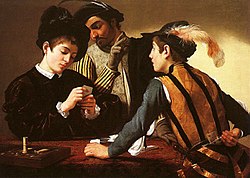Card sharp: Difference between revisions
Marasmusine (talk | contribs) m category |
m →Magician's view: Wikify Michael Ammar |
||
| Line 8: | Line 8: | ||
==Magician's view== |
==Magician's view== |
||
The use of these methods to cheat at cards is generally frowned upon by magicians, as they can paint magicians as swindlers. However, they often use card sharps as the subject for card routines, to show off their skills. For example, [[Derek Dingle]] created an effect, later modified by Michael Ammar and performed on television with a slightly different handling, while retaining the same handling of the deck, inserts the four aces into the deck, shuffles the cards (face-up into face-down), and finds all of them in 30 seconds under the watchful eye of 2 casino security people, leaving 4 royal flushes — all face up — in the end. |
The use of these methods to cheat at cards is generally frowned upon by magicians, as they can paint magicians as swindlers. However, they often use card sharps as the subject for card routines, to show off their skills. For example, [[Derek Dingle]] created an effect, later modified by [[Michael Ammar]] and performed on television with a slightly different handling, while retaining the same handling of the deck, inserts the four aces into the deck, shuffles the cards (face-up into face-down), and finds all of them in 30 seconds under the watchful eye of 2 casino security people, leaving 4 royal flushes — all face up — in the end. |
||
==Etymology== |
==Etymology== |
||
Revision as of 14:20, 3 January 2007

A card sharp (as opposed to a card shark) is a person who purposely cheats at cards with the aim of making money. Card sharps are also known as "mechanics" — an older term is "greek".
Methods
Card sharps typically use methods also employed by magicians to keep control of the order of the cards or sometimes to control one specific card. Most, if not all, of these methods employ sleight of hand. Essential skills are the false shuffles and "false cuts" that appear to mix the deck but actually leave the cards in the same order. More advanced techniques include "culling", which is manipulating desired cards to the top or bottom of the deck, and "stacking", which puts desired cards in position to be dealt.
Dealing can also be manipulated by dealing either the bottom card from the deck or the second one from the top instead of the top card. These are called the "bottom deal" and the "second deal" respectively.
Magician's view
The use of these methods to cheat at cards is generally frowned upon by magicians, as they can paint magicians as swindlers. However, they often use card sharps as the subject for card routines, to show off their skills. For example, Derek Dingle created an effect, later modified by Michael Ammar and performed on television with a slightly different handling, while retaining the same handling of the deck, inserts the four aces into the deck, shuffles the cards (face-up into face-down), and finds all of them in 30 seconds under the watchful eye of 2 casino security people, leaving 4 royal flushes — all face up — in the end.
Etymology
The etymology of the term "card sharp" is debated. A popular theory is that it comes from the German word Scharper, which in one sense means swindler. Another theory, which is likely false etymology, is that card sharp is a degenerate form of card shark, which itself is an analogy to the term pool shark. In actuality, the reverse is more likely to be true: card sharp is the original term, and card shark was likely formulated later, influenced by corruption of the term card sharp and by either analogy to pool shark or as a fresh shark metaphor.
In film
Card sharps are often common characters in caper films, since the questionable legality and morality of their hobby also plays well with that of their occupation. Examples of such films are:
On television
- Sanford and Son featured an episode where card sharps defeated Lamont at poker; while he went to get drinks, Fred was able (through a specially marked deck and one of his many pairs of reading glasses) to defeat the card sharps and win Lamont's money back.
- Harry Anderson made several appearances on Cheers as card sharp "Harry the Hat."
